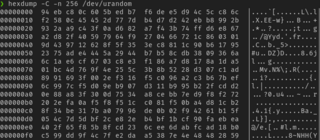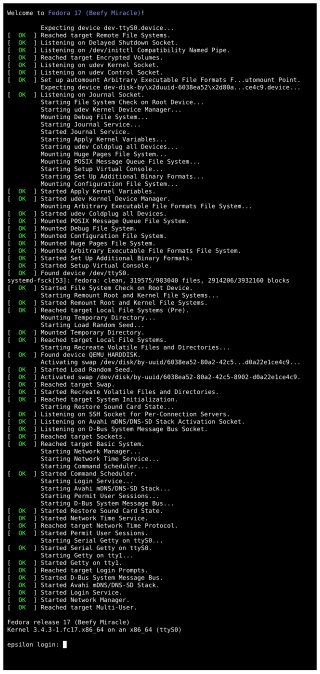In the Linux kernel, kernfs is a set of functions that contain the functionality required for creating the pseudo file systems used internally by various kernel subsystems so that they may use virtual files. For example, sysfs provides a set of virtual files by exporting information about hardware devices and associated device drivers from the kernel's device model to user space.
The creation of kernfs resulted from splitting off part of the internal logic used by sysfs. The associated patchset, with Tejun Heo as its main author, was merged into the Linux kernel mainline in kernel version 3.14, which was released on March 30, 2014. [1] [2] Kernfs took the independent and reusable functionality of sysfs so other kernel subsystems can implement their own pseudo file systems more easily and consistently. [1] [3] [4]
One of the primary users of kernfs is the pseudo file system used internally by cgroups, whose redesign continued into version 3.15 of the Linux kernel. [5]
The Filesystem Hierarchy Standard (FHS) is a reference describing the conventions used for the layout of a UNIX system. It has been made popular by its use in Linux distributions, but it is used by other UNIX variants as well. It is maintained by the Linux Foundation. The latest version is 3.0, released on 3 June 2015.
A chroot on Unix and Unix-like operating systems is an operation that changes the apparent root directory for the current running process and its children. A program that is run in such a modified environment cannot name files outside the designated directory tree. The term "chroot" may refer to the chroot(2) system call or the chroot(8) wrapper program. The modified environment is called a chroot jail.

In Unix-like operating systems, /dev/random and /dev/urandom are special files that serve as cryptographically secure pseudorandom number generators. They allow access to environmental noise collected from device drivers and other sources. /dev/random typically blocked if there was less entropy available than requested; more recently it usually blocks at startup until sufficient entropy has been gathered, then unblocks permanently. The /dev/urandom device typically was never a blocking device, even if the pseudorandom number generator seed was not fully initialized with entropy since boot. Not all operating systems implement the same methods for /dev/random and /dev/urandom.
udev is a device manager for the Linux kernel. As the successor of devfsd and hotplug, udev primarily manages device nodes in the /dev directory. At the same time, udev also handles all user space events raised when hardware devices are added into the system or removed from it, including firmware loading as required by certain devices.
The Direct Rendering Manager (DRM) is a subsystem of the Linux kernel responsible for interfacing with GPUs of modern video cards. DRM exposes an API that user-space programs can use to send commands and data to the GPU and perform operations such as configuring the mode setting of the display. DRM was first developed as the kernel-space component of the X Server Direct Rendering Infrastructure, but since then it has been used by other graphic stack alternatives such as Wayland and standalone applications and libraries such as SDL2 and Kodi.

Git is a distributed version control system that tracks changes in any set of computer files, usually used for coordinating work among programmers collaboratively developing source code during software development. Its goals include speed, data integrity, and support for distributed, non-linear workflows.
The proc filesystem (procfs) is a special filesystem in Unix-like operating systems that presents information about processes and other system information in a hierarchical file-like structure, providing a more convenient and standardized method for dynamically accessing process data held in the kernel than traditional tracing methods or direct access to kernel memory. Typically, it is mapped to a mount point named /proc at boot time. The proc file system acts as an interface to internal data structures about running processes in the kernel. In Linux, it can also be used to obtain information about the kernel and to change certain kernel parameters at runtime (sysctl).
sysfs is a pseudo file system provided by the Linux kernel that exports information about various kernel subsystems, hardware devices, and associated device drivers from the kernel's device model to user space through virtual files. In addition to providing information about various devices and kernel subsystems, exported virtual files are also used for their configuration.

The Linux kernel provides several interfaces to user-space applications that are used for different purposes and that have different properties by design. There are two types of application programming interface (API) in the Linux kernel that are not to be confused: the "kernel–user space" API and the "kernel internal" API.

Out of memory (OOM) is an often undesired state of computer operation where no additional memory can be allocated for use by programs or the operating system. Such a system will be unable to load any additional programs, and since many programs may load additional data into memory during execution, these will cease to function correctly. This usually occurs because all available memory, including disk swap space, has been allocated.
A Unix architecture is a computer operating system system architecture that embodies the Unix philosophy. It may adhere to standards such as the Single UNIX Specification (SUS) or similar POSIX IEEE standard. No single published standard describes all Unix architecture computer operating systems — this is in part a legacy of the Unix wars.
A kernel is a component of a computer operating system. A comparison of system kernels can provide insight into the design and architectural choices made by the developers of particular operating systems.
Netlink is a socket family used for inter-process communication (IPC) between both the kernel and userspace processes, and between different userspace processes, in a way similar to the Unix domain sockets available on certain Unix-like operating systems, including its original incarnation as a Linux kernel interface, as well as in the form of a later implementation on FreeBSD. Similarly to the Unix domain sockets, and unlike INET sockets, Netlink communication cannot traverse host boundaries. However, while the Unix domain sockets use the file system namespace, Netlink sockets are usually addressed by process identifiers (PIDs).
In operating systems, write barrier is a mechanism for enforcing a particular ordering in a sequence of writes to a storage system in a computer system. For example, a write barrier in a file system is a mechanism that ensures that in-memory file system state is written out to persistent storage in the correct order.

The Linux kernel is a free and open-source, monolithic, modular, multitasking, Unix-like operating system kernel. It was originally authored in 1991 by Linus Torvalds for his i386-based PC, and it was soon adopted as the kernel for the GNU operating system, which was written to be a free (libre) replacement for Unix.

Linux Containers (LXC) is an operating-system-level virtualization method for running multiple isolated Linux systems (containers) on a control host using a single Linux kernel.

systemd is a software suite that provides an array of system components for Linux operating systems. The main aim is to unify service configuration and behavior across Linux distributions. Its primary component is a "system and service manager" – an init system used to bootstrap user space and manage user processes. It also provides replacements for various daemons and utilities, including device management, login management, network connection management, and event logging. The name systemd adheres to the Unix convention of naming daemons by appending the letter d. It also plays on the term "System D", which refers to a person's ability to adapt quickly and improvise to solve problems.
cgroups is a Linux kernel feature that limits, accounts for, and isolates the resource usage of a collection of processes.
zswap is a Linux kernel feature that provides a compressed write-back cache for swapped pages, as a form of virtual memory compression. Instead of moving memory pages to a swap device when they are to be swapped out, zswap performs their compression and then stores them into a memory pool dynamically allocated in the system RAM. Later writeback to the actual swap device is deferred or even completely avoided, resulting in a significantly reduced I/O for Linux systems that require swapping; the tradeoff is the need for additional CPU cycles to perform the compression.
In the Berkeley Software Distribution (BSD) and its descendants, kernfs is a pseudo file system that provides access to information on the currently running kernel. The file system itself and its content are dynamically generated when the operating system is booted, and the kernfs is often mounted at the /kern directory. As a result of its nature, kernfs does not consist of actual files on a storage device, allowing instead processes to retrieve system information by accessing virtual files.